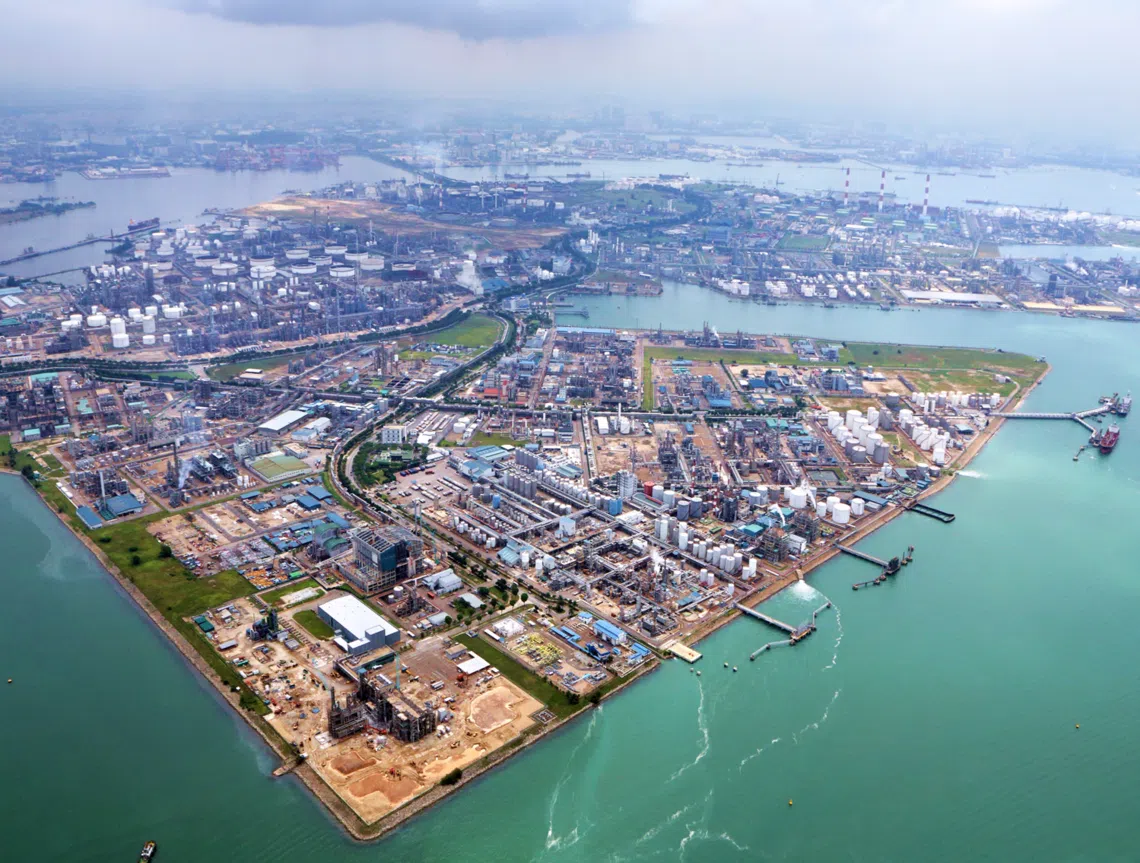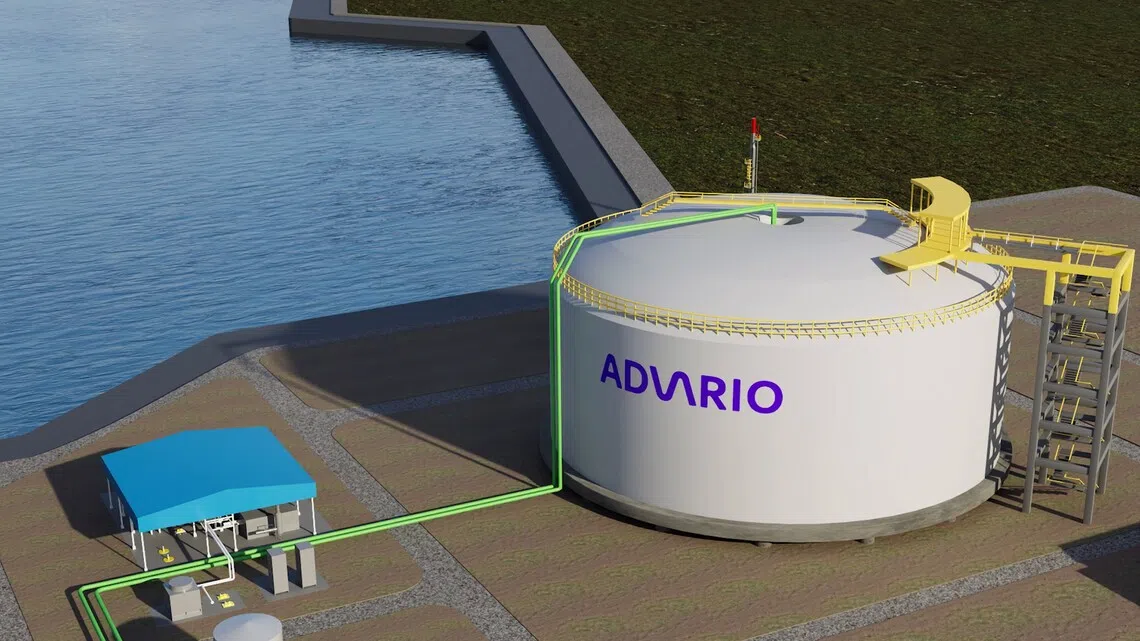Jurong Island’s ‘balancing act’: Going green while sustaining jobs and growth
The petrochemical hub’s transition comes amid the oil down-cycle and a looming carbon tax hike
[SINGAPORE] As Singapore’s Jurong Island embarks on a green pivot, the energy and chemicals hub will have to tread a fine balance in pursuing new sustainable ventures while maintaining growth and cost-competitiveness.
This is especially amid the current oil and gas down-cycle – with layoffs rocking the sector – and the Republic’s upcoming carbon tax hike, which could drive up operating costs.
“The government must protect the jobs and economic activity that Jurong Island supports today, while accelerating the move to lower‑carbon production required to meet our 2050 net‑zero goal,” said Eddison Lee, principal in the energy and natural resources practice at Oliver Wyman. He noted that Singapore faces a “careful balancing act”.
On Monday (Oct 27), the Republic unveiled plans to accelerate Jurong Island’s green transformation from its traditional oil and gas focus.
This includes setting up a low-carbon data centre park with a capacity of up to 700 megawatts, and allocating close to 300 hectares of land for new energy solutions, such as energy-storage systems and ammonia.
Singapore also aims to develop Jurong Island into a hub for specialty chemicals and sustainable materials. This is expected to create new jobs such as manufacturing operations, research and innovation, and process engineering.
A NEWSLETTER FOR YOU
Friday, 12.30 pm
ESG Insights
An exclusive weekly report on the latest environmental, social and governance issues.
Need to transform
These moves are necessary in the light of the global energy transition, experts and industry players told The Business Times.
Global demand for petrochemicals is likely to “begin a slow decline due to the electrification of many modes of transport”, said Ben McCarron, founder and managing director of Asia Research and Engagement (ARE).
Singapore also faces growing competition in the refining sector, with state oil companies investing in refining capacity in Asia, he noted.
Sam Chua of Rystad Energy is likewise seeing stiffer competition with the rise of larger and more integrated facilities in Asia and the Middle East.
“(Margin) leadership now sits with very large, tightly integrated petrochemical-refinery complexes in China, India and the Middle East,” said Chua, Rystad’s principal for advisory in Asia-Pacific.
The fact that smaller and older plants are being rationalised or repurposed is “a structural trend rather than a cycle blip”, he added.
Singapore is already seeing layoffs and asset sales amid the current oil and gas down-cycle.
ExxonMobil has said that it will cut up to 500 Singapore employees by end-2027, and on Friday announced the sale of its petrol kiosks here. Last year, Shell sold its assets on Jurong Island and Pulau Bukom to a joint venture of Indonesia’s Chandra Asri and global trading house Glencore.
Adding to the challenging oil and gas outlook, Singapore’s carbon tax rate will rise to S$45 per tonne in 2026 and 2027, and is expected to hit S$50 to S$80 per tonne by 2030.
The tax applies to facilities that directly emit at least 25,000 tonnes of greenhouse gases annually, such as refineries and petrochemical plants.
Short-term versus long-term needs
While the impetus for Jurong Island to transform is clear, the process will also need to balance short-term economic needs with longer-term sustainability goals.
“This is not easy to do as priorities may differ or shift over the short term,” McCarron of ARE said.
“However, the long-term necessity to transition to a lower-carbon economy remains and at some point, multinational corporations will have to align their short-term priorities to the pathway of longer-term sustainability.”
A careful combination of rebates and incentives could help Singapore strike the right balance in greening the energy and chemicals sector.
Last year, it was reported that Singapore offered refiners and petrochemical companies carbon tax rebates of up to 76 per cent for 2024 and 2025.
Singapore rolled out a transition framework in 2024 to support emissions-intensive and trade-exposed companies, noted a spokesperson for the Singapore Economic Development Board, when asked about the rebates.
“The amount of allowances awarded to each facility is determined based on its performance on internationally recognised efficiency benchmarks where available, and the facility’s decarbonisation plans,” he said, adding that the amount awarded will be regularly reviewed.

The upcoming rise in carbon tax “raises valid concerns around cost-competitiveness”, said Mark Addy, a KPMG partner involved in energy and natural resources.
“In the short term, we may continue to see rebates introduced to help manage this transition. However, the effectiveness of such rebates depends heavily on how they are structured and the conditions attached,” he said.
For instance, carbon tax rebates could be conditional on verified carbon intensity reduction.
“What’s important is to avoid blanket exemptions, which risk undermining the integrity of the carbon pricing system,” said Addy.
“A performance-based approach creates a more transparent and accountable pathway for large emitters, encouraging real progress rather than passive compliance.”
Toh Shu Hui, partner for corporate tax services at Ernst & Young Solutions, said measures such as rebates are “not intended to dilute the carbon price signal, but to provide time for companies to invest in low-carbon technologies and transformation”.
Beyond rebates, funding and grant support for low-carbon technology research will be critical, she noted.
Making the transition
Jurong Island-based companies BT spoke to agree with the need to invest in green projects, even as they battle economic and cost challenges.
Petrochemicals player PCS, for instance, is buying bio-naphtha – a sustainable form of the hydrocarbon naphtha – from companies such as Neste. This enables it to produce greener forms of its products: bio-ethylene and bio-propylene.
PCS is also collaborating with UK recycling company Mura Technology to promote circular economy solutions. It has provided Mura with rights to a site in Jurong Island for a new advanced recycling facility that can produce “circular naphtha” from waste plastic.
Such projects involve high costs. For instance, bio-naphtha can be two-and-a-half to three times the price of conventional naphtha, while circular naphtha can cost three to three-and-a-half times.
But PCS still sees value in investing early. “As the technology improves and this class (of products) becomes bigger and sizes up, then hopefully you can reduce the cost,” said Lilian Lee, PCS’ commercial lead for sustainability and corporate general manager.

Chemicals storage specialist Advario Asia-Pacific is likewise investing in green projects despite the high costs.
For instance, local startup VFlowTech is tapping Advario’s storage tank infrastructure for scaling a vanadium redox flow battery, to a capacity that could power more than 3,000 four-room flats daily.
Advario is also part of a Keppel-led consortium that Singapore has appointed to study clean ammonia power generation and bunkering on Jurong Island.
As part of the project, Advario will be building a large-scale ammonia tank, said Kevin Jen, Advario’s director for deal execution and business development in Asia and Oceania.
Ammonia storage is expensive, as the fuel is toxic and corrosive, and needs to be kept under cryogenic conditions.
Asked why Advario is investing in ammonia storage despite the high cost, Jen said: “(If) I only focus on what can make money now, that’s very myopic.
“You need to actually look into the future and take a strategic view… Cash flows may be quite challenging in the early years, but subsequently, they might pick up.”
“Rejuvenation”
Singapore is working closely with existing companies on Jurong Island to “upgrade and transform their operations”, said Kelly Lai, EDB’s vice-president for chemicals and materials.
The focus is also on capturing new opportunities in sustainable solutions and higher-value specialty chemicals, said Lai, while noting that Singapore is not immune to global macro conditions.
“Due to the global petrochemical down-cycle, companies are reviewing their footprints globally, and we are not sheltered from these global developments. Also, with any mature industry, we would expect to see some churn,” she said.
However, she noted that churn would be followed by “reinvestment and rejuvenation”. Singapore also remains home to ExxonMobil’s largest manufacturing site and a regional hub for Shell’s marketing and trading business.
“This reflects their continued trust in Singapore’s competitiveness as a leading energy and chemicals hub,” said Lai.


